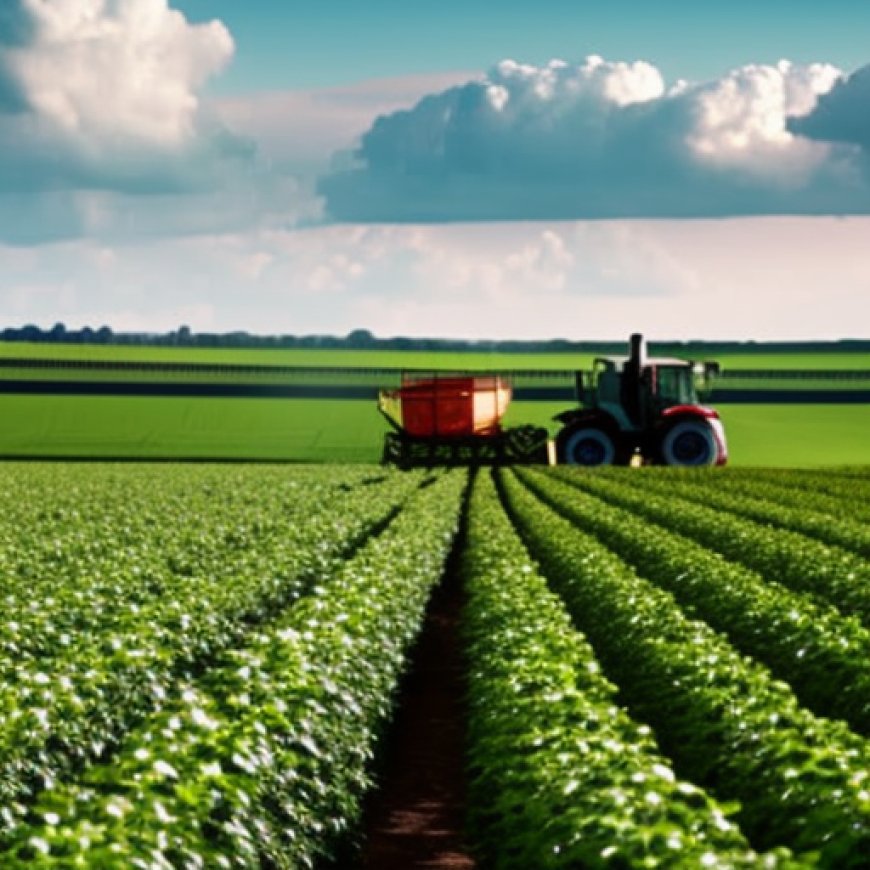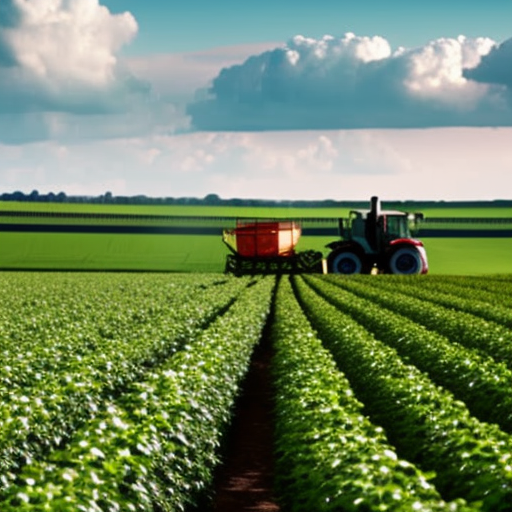Revolutionising agriculture: Here’s how biotechnology is changing farming practices
Revolutionising agriculture: Here’s how biotechnology is changing farming practices Business Today


The Role of Biotechnology in Revolutionizing Agriculture Towards Sustainability
The Dichotomy of Conventional vs. Sustainable Agriculture
In the face of climate change and environmental degradation, agriculture stands at a critical juncture. Conventional farming practices, characterized by intensive chemical use and unsustainable land management, are no longer viable solutions. To meet the challenges of the 21st century, we must embrace sustainable farming practices that prioritize environmental stewardship, economic viability, and social equity. But how do we achieve this Holy Grail? Biotechnology, with its innovative approaches and scientific advancements, is poised to lead the way in revolutionizing agriculture towards sustainability.
Conventional agriculture, driven by the pursuit of maximum yields and profit, has relied heavily on synthetic inputs and intensive farming practices. However, this approach has come at a cost – soil degradation, water pollution, and loss of biodiversity. In contrast, sustainable agriculture seeks to harmonize economic profitability with environmental stewardship and social equity. By integrating regenerative approaches and ecological principles, sustainable farming practices aim to ensure long-term food security and ecosystem resilience.
The Role of Biotechnology in Sustainable Agriculture
Biotechnology holds immense promise in transforming agriculture towards sustainability. Recent advancements in biotechnology research have focused on elucidating molecular mechanisms and applying this knowledge to improve crop yield and resilience. Genetic engineering, molecular breeding, process modulation, precision fermentation for high-value molecules, microbes and microbiome engineering are just a few examples of biotechnological tools that hold the key to sustainable farming practices.
Better Planting Material
One of the first adoptions of biotechnology for agriculture was done in the seed industry. Molecular breeding, genetic engineering, pathway modification, trait modification to now gene editing. Understanding underlying molecular mechanisms for future genetic engineering has fueled research in the past few decades.
Biologicals
However, more recently the knowledge of pathway modulation, molecular controls is being used to generate biologicals with molecules that modulate different traits. Widely known as “sprayable traits” for their ability to confer traits in crops. These molecular switches are at the forefront, leading the most cutting-edge research on biologicals. An example of this is Verdant, developed by Bioprime based on cell wall precursors that induce cell wall modification and strengthening, making crops drought and heat tolerant.
Yield Improvement
Yield improvement focuses on better enzymatic processes like RUBISCO for better photosynthesis and higher photosynthesizing ability even in stress conditions. The metabolic pathway of photorespiration detoxifies it for performing photosynthesis in O2 containing atmosphere, which can cost a yield penalty of 20% to 50% depending on the environmental conditions and the type of photosynthesis employed.
Enhancing Nutrient Use Efficiency
Maximizing nutrient use efficiency (NUE) is critical for sustainable agriculture, as it reduces fertilizer input, improves yield, and minimizes environmental losses. Biotechnology offers innovative solutions for enhancing NUE, such as genetic manipulation of nutrient uptake and metabolism genes and the development of microbial strains that improve nutrient availability and uptake. For example, the overexpression of key genes involved in nitrogen metabolism, such as glutamine synthetase (GS) and nitrate transporters (NRT), has been shown to significantly enhance NUE in crop plants, resulting in higher yields and reduced nitrogen runoff.
Building Climate Resilience
Climate change poses a significant threat to global food security, with extreme weather events and changing climatic patterns impacting crop production worldwide. Biotechnology offers tools for developing climate-resilient crop varieties that can withstand abiotic stresses such as drought, salinity, and temperature extremes. For instance, the development of genetically engineered maize varieties with enhanced drought tolerance through the overexpression of drought-responsive genes has enabled farmers to maintain yields under water-stressed conditions, reducing crop losses and ensuring food security in drought-prone regions.
Harnessing the Power of the Microbiome
The plant microbiome plays a crucial role in determining crop health and resilience to environmental stresses. By harnessing the power of beneficial microbes, microbiome engineering can improve disease resistance, nutrient uptake, and stress tolerance in crops, leading to higher yields and reduced chemical inputs. For example, the inoculation of crop plants with beneficial microbial consortia has been shown to enhance plant growth, yield, and stress tolerance in various crops, including rice, wheat, and soybean. Microbes associated with Sorghum from arid regions were shown to enhance crop resilience in tomato, chili, etc.
Promoting Nutrient-Dense Food
Biofortification, the process of increasing the nutrient content of crops through conventional breeding or biotechnological methods, offers a promising solution to malnutrition and food insecurity. Biotechnology enables the development of nutrient-dense crop varieties with improved nutrient uptake and retention, ensuring access to nutritious food for all. For example, the development of biofortified rice varieties with enhanced iron and zinc content through genetic engineering has been successfully commercialized in several countries, addressing micronutrient deficiencies and improving public health outcomes.
The agricultural revolution in the 21st century is the cumulative effect of improved agronomic management, plant breeding, fertilizer technology, and farm mechanization, which has dramatically improved crop production. However, climate change, abiotic and biotic stress, biodiversity losses, and soil degradation will potentially affect crop production, as studies have described yield stagnation and increased yield variability in recent years. As we stand on the cusp of a new agricultural revolution, biotechnology emerges as a powerful tool for transforming farming practices towards sustainability. From enhancing nutrient use efficiency to building climate resilience and promoting nutrient-dense food, biotechnology holds the key to a sustainable future for agriculture and our planet. Let us embrace the power of biotechnology and embark on a journey towards a more sustainable and resilient food system.
Views are personal. The author is Co-Founder & CEO, BioPrime AgriSolutions
SDGs, Targets, and Indicators in the Article
1. Sustainable Development Goals (SDGs) Addressed:
- SDG 2: Zero Hunger
- SDG 3: Good Health and Well-being
- SDG 6: Clean Water and Sanitation
- SDG 12: Responsible Consumption and Production
- SDG 13: Climate Action
- SDG 15: Life on Land
2. Specific Targets Identified:
- Target 2.3: By 2030, double the agricultural productivity and incomes of small-scale food producers, in particular women, indigenous peoples, family farmers, pastoralists, and fishers, including through secure and equal access to land, other productive resources and inputs, knowledge, financial services, markets, and opportunities for value addition and non-farm employment.
- Target 2.4: By 2030, ensure sustainable food production systems and implement resilient agricultural practices that increase productivity and production, that help maintain ecosystems, that strengthen capacity for adaptation to climate change, extreme weather, drought, flooding, and other disasters, and that progressively improve land and soil quality.
- Target 3.9: By 2030, substantially reduce the number of deaths and illnesses from hazardous chemicals and air, water, and soil pollution and contamination.
- Target 6.3: By 2030, improve water quality by reducing pollution, eliminating dumping and minimizing release of hazardous chemicals and materials, halving the proportion of untreated wastewater, and increasing recycling and safe reuse globally.
- Target 12.4: By 2020, achieve the environmentally sound management of chemicals and all wastes throughout their life cycle, in accordance with agreed international frameworks, and significantly reduce their release to air, water, and soil to minimize their adverse impacts on human health and the environment.
- Target 13.1: Strengthen resilience and adaptive capacity to climate-related hazards and natural disasters in all countries.
- Target 15.1: By 2020, ensure the conservation, restoration, and sustainable use of terrestrial and inland freshwater ecosystems and their services, in particular forests, wetlands, mountains, and drylands, in line with obligations under international agreements.
3. Indicators Mentioned or Implied:
- Indicator 2.3.1: Volume of production per labor unit by classes of farming/pastoral/forestry enterprise size.
- Indicator 2.4.1: Proportion of agricultural area under productive and sustainable agriculture.
- Indicator 3.9.2: Mortality rate attributed to household and ambient air pollution.
- Indicator 6.3.1: Proportion of wastewater safely treated.
- Indicator 12.4.1: Number of parties to international multilateral environmental agreements on hazardous waste that meet their commitments and obligations in transmitting information as required by each agreement.
- Indicator 13.1.1: Number of deaths, missing persons, and directly affected persons attributed to disasters per 100,000 population.
- Indicator 15.1.1: Forest area as a proportion of total land area.
Table: SDGs, Targets, and Indicators
| SDGs | Targets | Indicators |
|---|---|---|
| SDG 2: Zero Hunger | Target 2.3: By 2030, double the agricultural productivity and incomes of small-scale food producers, in particular women, indigenous peoples, family farmers, pastoralists, and fishers, including through secure and equal access to land, other productive resources and inputs, knowledge, financial services, markets, and opportunities for value addition and non-farm employment. | Indicator 2.3.1: Volume of production per labor unit by classes of farming/pastoral/forestry enterprise size. |
| SDG 2: Zero Hunger | Target 2.4: By 2030, ensure sustainable food production systems and implement resilient agricultural practices that increase productivity and production, that help maintain ecosystems, that strengthen capacity for adaptation to climate change, extreme weather, drought, flooding, and other disasters, and that progressively improve land and soil quality. | Indicator 2.4.1: Proportion of agricultural area under productive and sustainable agriculture. |
| SDG 3: Good Health and Well-being | Target 3.9: By 2030, substantially reduce the number of deaths and illnesses from hazardous chemicals and air, water, and soil pollution and contamination. | Indicator 3.9.2: Mortality rate attributed to household and ambient air pollution. |
| SDG 6: Clean Water and Sanitation | Target 6.3: By 2030, improve water quality by reducing pollution, eliminating dumping and minimizing release of hazardous chemicals and materials, halving the proportion of untreated wastewater, and increasing recycling and safe reuse globally. | Indicator 6.3.1: Proportion of wastewater safely treated. |
| SDG 12: Responsible Consumption and Production | Target 12.4: By 2020, achieve the environmentally sound management of chemicals and all wastes throughout their life cycle, in accordance with agreed international frameworks, and significantly reduce their release to air, water, and soil to minimize their adverse impacts on human health and the environment. | Indicator 12.4.1: Number of parties to international multilateral environmental agreements on hazardous waste that meet their commitments and obligations in transmitting information as required by each agreement. |
| SDG 13: Climate Action | Target 13.1: Strengthen resilience and adaptive capacity to climate-related hazards and natural disasters in all countries. | Indicator 13.1.1: Number of deaths, missing persons, and directly affected persons attributed to disasters per 100,000 population. |
| SDG 15: Life on Land | Target 15
Behold! This splendid article springs forth from the wellspring of knowledge, shaped by a wondrous proprietary AI technology that delved into a vast ocean of data, illuminating the path towards the Sustainable Development Goals. Remember that all rights are reserved by SDG Investors LLC, empowering us to champion progress together. Source: businesstoday.in
Join us, as fellow seekers of change, on a transformative journey at https://sdgtalks.ai/welcome, where you can become a member and actively contribute to shaping a brighter future.
|








